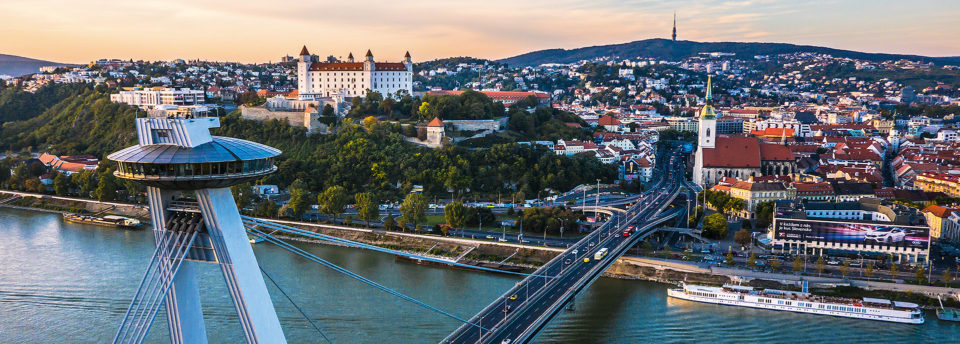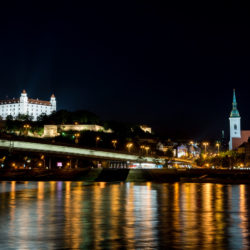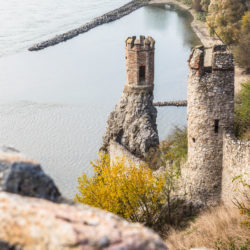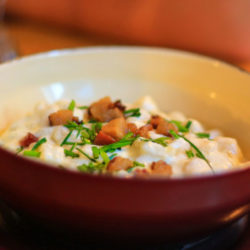The City
The Pan-European University is located in the capital city of Slovak Republic, Bratislava. Although counted among the most recent to become capital cities in Europe, Bratislava shares a history reaching more than 2000 years back in time.
The city is located along both shores of the Danube river, the second longest river of Europe, under the southwesternmost edge of the Carpathian mountain range (called the Small Carpathians). I tis situated in a very close proximity to Slovakia´s borders with Austria (to the west of Bratislava), Hungary (to the south of the city) and not far from the border to the Czech Republic either (in north-western direction from the city). The approximate number of Bratislava´s inhabitants is 500.000.
The first historic written mentioning of Bratislava appears in the year 907. In 1291 it has achieved (under the name Pressburg) its first unlimited privileges from the Hungarian king. In 1465 the first university on the territory of the current Slovak Republic was created, named Academia Istropolitana.
In 1536, for almost 200 years, Bratislava has become the capital of the Hungarian Monarchy and as such the place of coronation for Hungarian rulers, the seat of the monarch, the archbishop and other official institutions of state. In this period, a total of 11 Hungarian emperors were coronated in the St. Martin´s Cathedral of Bratislava (known under the Hungarian name Pozsony).
In 1919 Bratislava has become part of the newly-established Czecho-Slovak Republic. After a legal act of federalization of Czecho-Slovakia Bratislava became the capital of the Slovak Socialist Republic in 1968.
From 1993 Bratislava serves as the capital of the independent Slovak Republic, following a peaceful dissolution of Czecho-Slovakia. As such, the city is the centre of the state institutions, the public sector, as well as the economic, financial, cultural and educational focal point of the country. It is an important transportation hub, both at the crossroads of motorways and railways and as an important river city on the Danube. Bratislava has operates its own international airport, thus it is also situated in a close proximity to the Vienna International Airport (45 km west of Bratislava), serving its need as a both regional and inter-continental transportation hub.
As a centre of education Bratislava is the seat of 10 different public and private institutions of higher education.
Currently, Bratislava is considered to be one of the most dynamically developing cities, within one of the most perspective regions of Europe.

LIFE IN BRATISLAVA
Bratislava castle
It features in the first written reference to the city, which appears in the Annals of Salzburg of 907, in association with a battle between Bavarians and Hungarians. The castle hill was populated as early as the late Stone Age, its first known inhabitants where the Celts, who founded a fortified settlement here called ‘Oppidum’.
Devín castle
The castle which witnessed the glory and fall of Great Moravia and was blown up by the Napoleonic army. Later it was declared to be a national cultural monument of Slovakia. Since it is situated on a high cliff over the Morava and Danube rivers, and standing on the frontier between Slovakia and Austria, it offers beautiful panoramic views and is a very popular place to visit. Come here if you want to soak in the rich medieval history which is mirrored in its ruins.
Gastronomy
Traditional Slovak foods can be found on nearly every menu, although foreign dishes are more typical in many restaurants. Such dishes include soup with halušky (dumplings), Bratislavský guláš (Bratislava-style goulash) and kapor na mlynársky spôsob (breaded and fried carp). The Small Carpathian Region is celebrated for its traditional husacina (roast goose), which is served with lokše (potato crepes) and is incredibly popular in the autumn during goose feasts.
Potatoes are highly prevalent in traditional local meals. A good Slovak lunch should never be without soup, with offerings including kapustnica (spicy sauerkraut soup), cesnačka (garlic soup), fazuľovica s párkom (bean soup with sausage) and hovädzí (beef) or slepačí vývar (chicken broth). Global soft drink brands in Slovakia face stiff competition from local soft drinks and a diverse selection of local table mineral waters.


